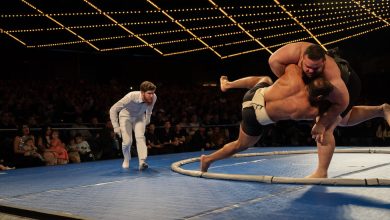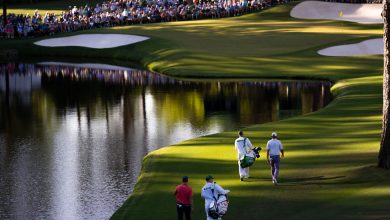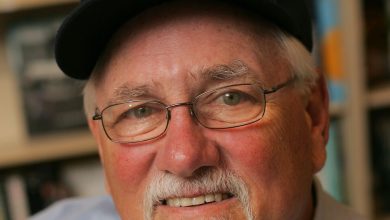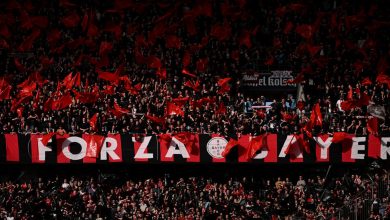He Suffered ‘the Worst Injury of the Tokyo Games.’ Can He Recover?

HENDERSON, Nev. — Next to the upstairs room where Connor Fields displays the choicest mementos of his BMX racing triumphs — framed jerseys, championship trophies, the Olympic gold medal from 2016 — is a laundry room. It holds a different kind of souvenir, the flip side of success.
On a hanger is a shredded, stained United States racing jersey. It is torn across the shoulders and the back from a wreck that Fields does not remember. It is sliced open in the front, the blunt work of paramedics trying to save his life.
On another hanger are his Team U.S.A. racing pants, chewed open at the knees.
Down in the garage, the walls papered with so many giant novelty winners’ checks that they now get put on the ceiling, is a plain brown box. In the box is the red, white and blue helmet that Fields wore when he crashed, headfirst, in the kind of life-altering wreck that every racer fears.
The helmet saved his life, Fields is certain. It is intact, but grated on the chin and the forehead, and a piece is missing.
“I’d rather tear every ligament in my body before I had a gnarly concussion,” Fields said. “This was my nightmare.”
The nightmare is a traumatic brain injury. Dr. Jonathan Finnoff, the chief medical officer for the United States Olympic and Paralympic Committee, attended to Fields in Tokyo and shepherded him through his early care.
“It was the worst injury the Olympics had,” Dr. Finnoff said. “Not just Team U.S.A. It was the worst injury of the Tokyo Summer Games.”
Fields, 29, is recovering quietly at home, with his fiancée, Laura Gruninger, and their two dogs, and the outward signs are positive. He is up and about, able to drive, to talk, even to make public appearances. He can fool people into thinking he’s back to normal. He is not. He knows it.
The forgotten or confused words. The fatigue. The mood swings. The annoyance of background noises. The persistent need for naps. The occasional imperative for quiet and dark.
The lingering question, unanswerable and unnerving, is whether his brain will ever get back to what it used to be.
“The way I feel today is not how I want to feel for the rest of my life,” he said.
Most progress after a brain injury comes in the first three months, doctors said. And no one knows how to quantify any of it with precision. Is Fields at 50 percent? Eighty percent? Will he ever know that he’s fully healed?
For now, he is not cleared to do anything remotely risky, even get on a bike to ride around the neighborhood. The season ticket he bought long ago to snowboard this winter is likely to go unused.
“We’re talking about the rest of my life here,” Fields said. “I can wait a few months, if it means not hurting my brain anymore.”
‘There’s Zero We Can Do’
Fields’ view of the crash is only through replay video. The blank spot in his memory extends from several hours before the wreck until about five days after it.
He does not remember the first two semifinal runs on July 30, where he finished third, then first. He remembers nothing of the third run, where he was injured. But scattered memories are resurfacing. A clip of the rain delay that morning, of wiping down his tires with a towel, popped into his head recently, like a discovered Zapruder film.
Last weekend, Fields sat at his kitchen table and watched the televised version of the race on a laptop.
“At this point we’re pretty even, me and the two Frenchmen,” Fields said, pausing the video after the race’s first couple of seconds.
The event took place at Ariake Urban Sports Park, on a serpentine track of three banked corners and four straightaways filled with rolls and jumps. Top racers got to the finish line, unscathed, in about 40 seconds.
BMX racing can be both dazzling and dangerous. Like driving in NASCAR, speed and tight cornering raise the stakes, but other racers are the wild cards. BMXers dip and weave like birds in a flock. One rider out of sync can cause chaos.
Because Fields won the second run, he had his choice of lanes for the third. He took Lane 1, the inside track to the first big turn.
Romain Mahieu, a 26-year-old racer with a reputation for not being aggressive enough, was in Lane 8, on the opposite end of the starting gate.
The two quickly burst to the front. They launched off a jump, one with a big lip and a short landing area that had vexed riders in practices and races.
Fields had a slight lead but flew a bit long — a mistake. Mahieu, on the outside, landed perfectly on the downslope and got a boost in speed. He instinctively saw an opportunity and angled left, toward the inside, just as the riders hit another jump.
“We’re both in the air right now, and there’s zero we can do,” Fields said, pointing at the screen and playing one frame at a time. “He lands right in front of me and — bang — hits my tire, and his hip hits my hand. Just looking at how my bike’s positioned, I’m going down. There’s nothing I can do.”
His tone is analytical, not angry.
“I don’t think it was a malicious, intended move,” Fields said.
He still has the confident voice of a salesman, and he might be selling forgiveness to himself. He voices the inevitable what-ifs in the frame of chance, not intent. What if either of us had landed just another inch or two one way or another?
No crash, probably. Maybe a gold medal. When Fields was hospitalized, he received a message from Mahieu, offering best wishes. They have not connected since. Fields clicked to the next frame.
His handlebars twisted, the front wheel turned sideways. In a blink, Fields flipped forward, landing squarely on the right side of his face.
“Why it was so bad is that I didn’t have time to brace for the impact,” Fields said. “It happened so fast, I didn’t have my hands out. I didn’t have time to tuck. I didn’t have time to do anything to get ready.”
Sylvain Andre of France and Twan Van Gendt of the Netherlands tumbled over Fields. They got up, untangled themselves and their bikes, and rode on.
Mahieu coasted to victory in the semifinal and finished sixth in the one-race final.
Fields, his body streaked by road rash, sat up for a moment then slumped back down, unconscious. Medics huddled around him. Fields lay on the track motionless for several minutes before he was carried away on a stretcher and put into an ambulance. There was further delay because of uncertainty over which hospital would take him.
All the while, Fields’ brain was bleeding.
The official diagnosis was subarachnoid hemorrhage and subdural hematoma — bleeding and the pooling of blood on the surface of the brain. There were multiple contusions and axonal injuries — the shearing, or tearing, of the nerve fibers — scattered throughout the brain, from the tip of the right frontal lobe to the deep recesses of the corpus callosum.
The range of memory loss he had, from before the accident until days later, places his traumatic brain injury in the category of “moderate.” But moderate best describes an injury when it happens to someone else.
‘He Couldn’t Tell Me Anything’
Because of Covid-19 protocols, the Tokyo Olympics had no fans in the stands, and foreign athletes like Fields had no friends or family in Japan. When Fields crashed, it was late morning in Tokyo but prime time in the United States.
Gruninger was home, watching with her parents. All they or anyone in the United States knew was that Fields was knocked out and taken away in an ambulance.
“I remember your dad calling me, Connor, and he had gotten a call from somebody on site there,” Gruninger said, recounting part of the episode that Fields had not heard. “He said: ‘Connor’s not breathing. They had to create an airway for him.’ And then your dad’s like: ‘Wait, they’re calling back. I have to go.’”
In Tokyo, Dr. Finnoff was at the Olympic Village when messages arrived.
“When I saw the accident on TV, my first thought was, oh, my gosh, not only did he ram his head down into the asphalt, but I wonder if he broke his neck, and now is a tetraplegic,” Dr. Finnoff said. “Finding out that he doesn’t have a broken neck and he’s moving his arms and legs was really, really great news.”
Dr. Finnoff met Fields in the emergency room of St. Luke’s International Hospital.
“I had to essentially yell to get him to open his eyes,” Dr. Finnoff said. “I could get him to say his name, but almost immediately he’d close his eyes. He didn’t know exactly what was going on. He didn’t know where he was. He couldn’t tell me anything.”
Having any response was a good sign, Dr. Finnoff said. A CT scan and M.R.I. assessed the damage. Dr. Finnoff was relieved to learn that there was no internal bleeding beyond the brain. Fields had a broken rib and a bruised lung, and serious scrapes and bruises.
“There are just so many other things he could have had,” Dr. Finnoff said.
To Gruninger, the first few days were agonizing. She tried not to think the worst — death, paralysis, permanent brain damage.
It was three days after the wreck when her phone buzzed, saying that Connor Fields wanted to FaceTime. She did not know what to expect. She found him looking back at her.
“I could tell you were groggy and tired,” Gruninger said to Fields in their kitchen. “But I could also tell that you were you.”
Before he fell asleep mid-conversation, Fields asked Gruninger about plans she had to see a friend, a detail that she was surprised he would recall.
“That was the first time that I felt any sense of relief,” Gruninger said.
Fields spent a week at the Tokyo hospital, then flew back to Las Vegas, accompanied by a coach and Team U.S.A. trainer. His stay at home was brief; he was taken to the University of Utah in Salt Lake City for about three weeks of evaluation and therapy.
“The first thing that started to really come back was the physical side of it — my balance, my coordination,” Fields said. “Within three weeks I was able to balance on one leg just fine, and do tasks that would have been hard for me initially.”
Much of the focus now is on processing speed and recall. Fields attends video sessions with a therapist, working on brain teasers.
“They’ll give me two words that are seven to nine letters long,” Fields said. “One of them yesterday was ‘quizzes’ and ‘accident.’ And I have to spell them, but alternating. So, like, Q, A, U, C — going back and forth, so you’re multitasking and spelling two words at the same time. That’s hard for anybody. What will happen is that I’ll be really good at it for a handful of words, and then I’ll just fall off a cliff, because of fatigue.”
He explained this at a local restaurant, over the soft din of a lunchtime crowd. He was lucid, quick, funny. Occasionally he winced at the background noise. Once home, his energy flagging, he napped for a couple of hours in a dim, quiet room.
“I don’t feel 100 percent normal, but pretty close to normal when I’m fresh,” he said the next day. “But when I get tired, it reverts back to how I was early on.”
Fields is in no hurry to decide his racing future.
“Nobody close to me has any interest in me coming back,” Fields said.
Maybe his final race is one that he never remembers.




